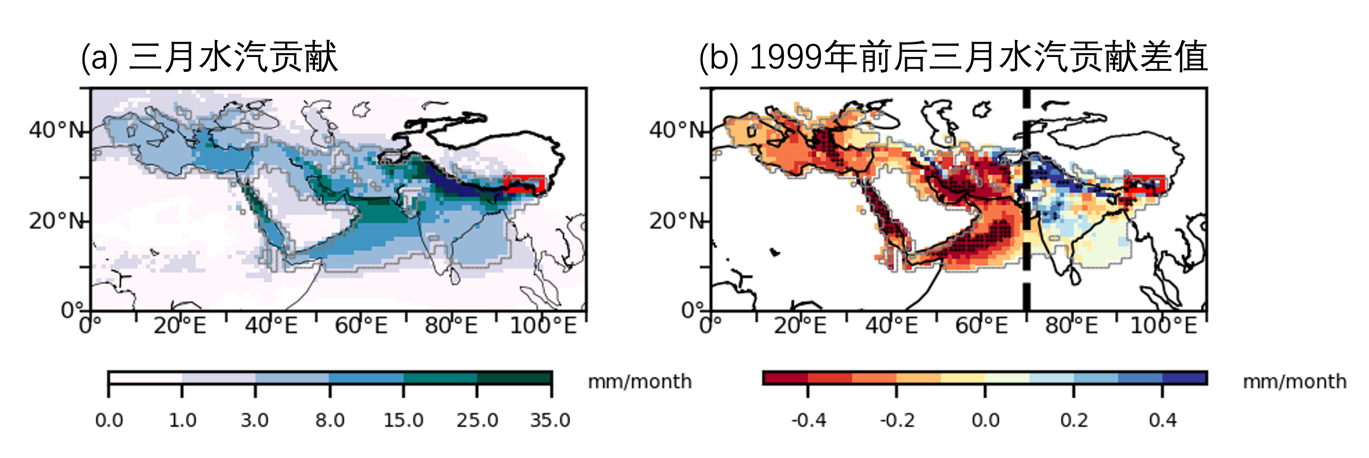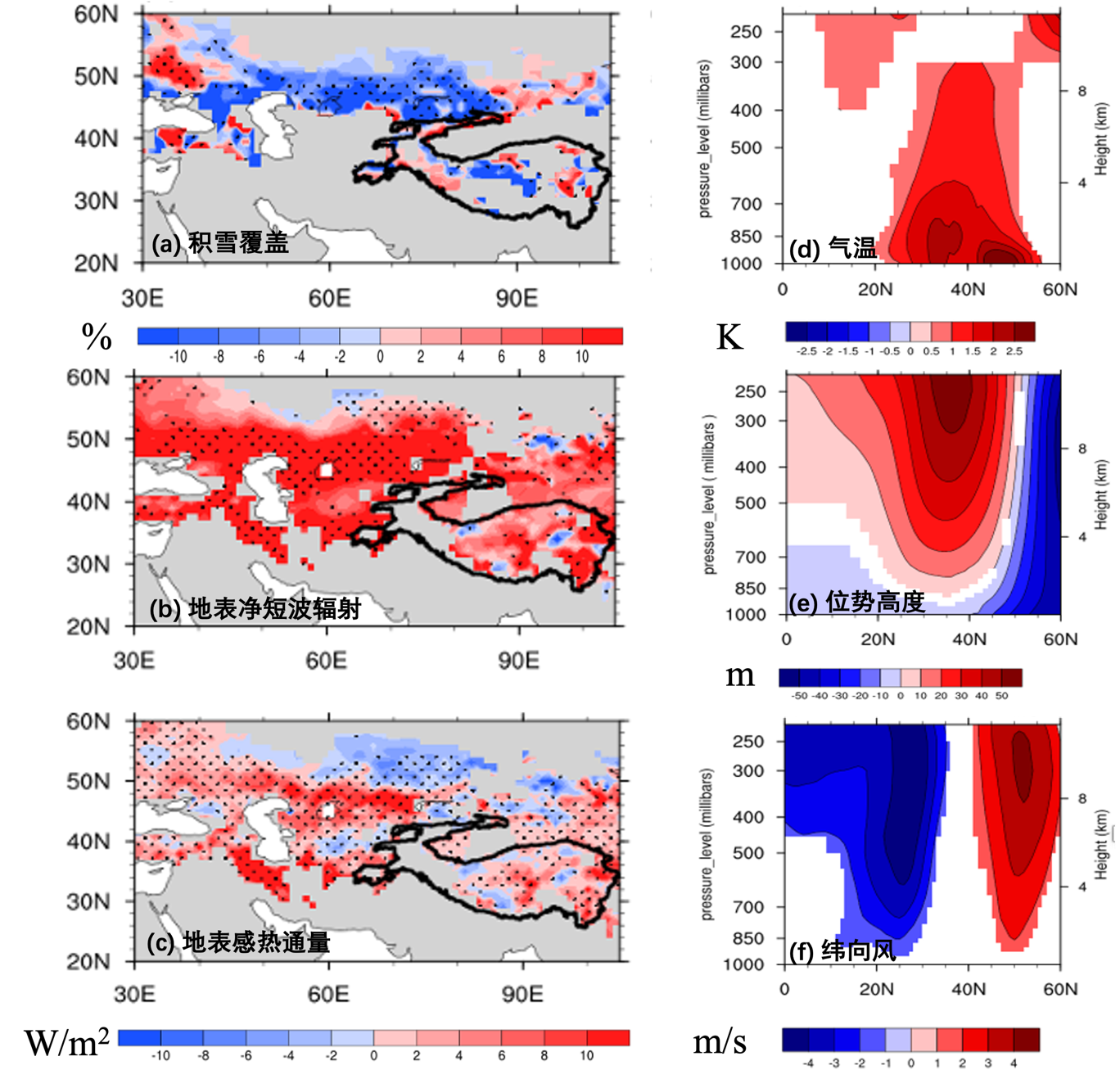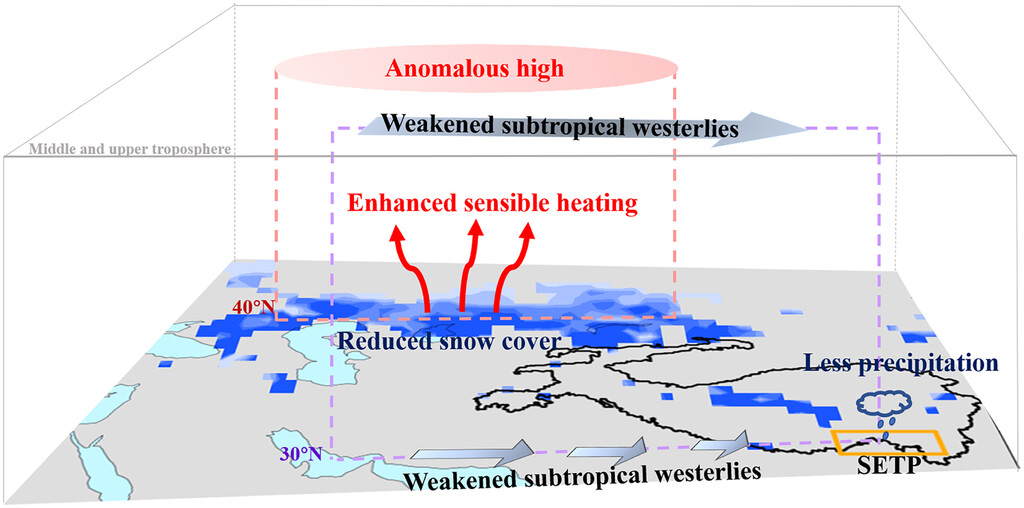The Southeast Tibetan Plateau (SETP) is a major region where many glaciers are located. Recent years have seen the significant shrinkage of glaciers in the SETP, posing a serious threat to downstream water resources. Glaciers in the SETP are mainly accumulated in spring and summer and predominantly in spring in some areas. Therefore, studying the changes of spring precipitation in the SETP is of great significance to the balance of local glacier mass. With regard to this problem, Yang Kun’s Research Group of the Department of Earth System Science (DESS), Tsinghua University has studied the decadal changes of spring precipitation in the SETP, disclosing the physical mechanism causing the change from the perspective of moisture transport.
First, station observations and the ERA5 reanalysis precipitation data are adopted to analyze the month-by-month change tendency of early spring precipitation in the SETP (27°-30°N, 92°-100°E). The results show that the March precipitation in the SETP has been reduced by 30% since 1999, while no significant changes have been observed in February and April precipitation. (Fig. 1)

Fig. 1 (a) The seasonal variation of precipitation averaged over the 12 station observations (OBS) in the SETP (27°–30°N, 92°–100°E) around 1999; and (b) data from atmospheric reanalysis of the global climate (ERA5), (c) The time series of precipitation in the SETP during the period of 1979–2017 (The gray line represents the means of 1979–98 and 1999–2017).
The study explores the cause for the substantial reduction of March precipitation in the SETP from the perspective of moisture transport. A Eulerian moisture backtrack model (WAM-2layers) was adopted to trace the moisture sources of March precipitation in the SETP. Climatologically, the primary moisture sources for precipitation in the SETP can be separated by the longitude of 70°E into the far-field and the near-field moisture sources. By comparing the moisture contribution difference of the far-field and near-field moisture sources during the two periods before and after 1999 (1979–98 minus 1999–2017), it is found that the moisture contribution from the near-field sources has increased at a decadal scale since 1999, whereas the moisture contribution from the far-field sources has decreased. So, it is the far-field moisture transport that caused the decrease in March precipitation in the SETP (Fig. 2). Since the change of moisture contribution is affected by the capability of moisture carrier and the amount of evaporative sources, the variation of the mean difference between 1999–2017 and 1979–98 in surface evaporation, zonal wind and zonal moisture flux at 700 hPa was analyzed, discovering that the change of surface evaporation was small, while impressive easterly wind anomalies prevailed along the 30°N belt region where the SETP is located (Fig. 3), indicating that the reduction of far-field moisture contribution is mainly attributed to the weakened subtropical westerlies.

Fig. 2 The distribution of climatological moisture contribution (unit: mm month21) to (a) the March precipitation in the SETP and (b) the difference between 1999–2017 and 1979–98. The gray solid line delineates the areas with a moisture contribution greater than 1 mm month21. The black dashed line in (b) denotes 70ºE. The red box represents the SETP, and the dots in (b) denote that the difference pass the significance test of p <0.1.

Fig. 3 The differences in the mean moisture transport (a) and zonal wind at 700 hPa (b) the differences in surface evaporation (unit: mm month−1) between 1999–2017 and 1979–98 in March. The yellow block represents the SETP. The black dashed line in (a) delineates 70°E. Shaded areas are the difference passing significance test of p < 0.1.

Fig. 4 The distributions of difference between 1999–2017 and 1979–98 of Eurasia snow cover extent (SCE) (a), surface net solar radiation (SSR) (b), sensible heat flux (SHF) (c) and air temperature (d), geopotential height (e) and zonal wind (f). Dots in the left denote the difference passing the significance test of p < 0.1. Black bold lines denote the 2,500 m geopotential height isoline. Shaded areas in the right are the difference passing significance test of p < 0.1.
To further explore the reason for the weakening of March tropical westerlies, the study analyzed the difference of early spring snow cover extent (SCE) between the two periods before and after 1999 in Eurasia (north of 40°N), discovering the significant reduction of Eurasia SE after 1999 (Fig. 4a), the increase of surface net solar radiation (SSR) and sensible heat flux (SHF) (Fig. 4b,c), and the abnormal temperature increase of the lower atmospheric air through snow albedos-radiation feedback (Fig. 4d). According to the theory of thermal adaption, an anomalous high was formed over the midlatitude (Fig. 4e), which caused an easterly anomaly in its south (30°N) through geostrophic adjustment, thus retarding the subtropical westerlies (Fig. 4f). The above results confirm that the reduction of snow cover in Eurasia weakens subtropical westerlies.
The physical process of snow cover in Eurasia affecting March precipitation in the SETP is demonstrated in Fig. 5. That is to say, in March, the snow cover in Eurasia decreased after 1999, and the surface was abnormally heated, which had led to the abnormal high in the upper troposphere, weakened the subtropical westerlies of 30°N, and reduced the long-distance water moisture transported to the SETP, resulting in the interdecadal decrease of March precipitation in the SETP. Despite the existence of a similar mechanism in February and April, the snow albedo-radiation feedback effect is weak in February, and the wind speed reduction caused by this feedback occurs in the northerly region in April. Therefore, so the precipitation reduction in the SETP is not obvious in these two months.

Fig. 5 Schematic diagram of the physical mechanism on the decadal decrease of March precipitation in the SETP.
This research has been recently published in Journal of Climate as a paper titled “Weakened Subtropical Westerlies Reduced Early Spring Precipitation in the Southeast Tibetan Plateau”. Yuan Xu, a doctoral fellow of the DESS, Tsinghua University is the first author of the paper, and his co-supervisor Prof. Yang Kun is the corresponding author. Collaborators are from the DESS, Tsinghua University and the Institute of Geographic Science and Natural Resources Research, Chinese Academy of Sciences. This work was supported by Strategic Priority Research Program of Chinese Academy of Sciences (Grant XDA2006010201) and National Science Foundation of China (Grant 41905087).
Full-text link of the paper: https://doi.org/10.1175/JCLI-D-22-0770.1
Written by Yuan Xu and Yang Kun
Edited by Wang Jiayin
Reviewed by Zhang Qiang